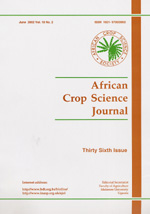
|
African Crop Science Journal
African Crop Science Society
ISSN: 1021-9730
EISSN: 1021-9730
Vol. 21, No. 1, 2013, pp. 75-83
|
 Bioline Code: cs13008
Bioline Code: cs13008
Full paper language: English
Document type: Research Article
Document available free of charge
|
|
|
African Crop Science Journal, Vol. 21, No. 1, 2013, pp. 75-83
| en |
COMPUTATIONAL IDENTIFICATION OF CONSERVED MICRO RNAs FROM KODO MILLET ( Paspalum scrobiculatum  ) )
NAGESH BABU, R.; JYOTHI, M.N.; SHARADAMMA, N.; SAHU, SARIKA; RAI, D.V. & DEVARAJ, V.R.
Abstract
Small RNA-guided gene silencing at the transcriptional and post-transcriptional levels has emerged as an important
mode of gene regulation in plants and animals. Micro RNAs (miRNA) arise from long stem loop precursors
which acted upon by DICER-Like enzymes. The miRNA and their precursor sequences are highly conserved
among the species and this forms a key feature for their identification through homology alignment. Computational
approach guides to identify the mature miRNAs as well as their precursors. The main principle behind the
computational miRNA prediction is sequence and structure homologies. The in silico search for the homologues
miRNA and their precursors among the Kodo millet ESTs enabled us to identify 4 miRNAs belonging to 3
families. A total of 34 targets were identified among which most were targeting the enzymes involved in fuel
metabolism, cellular transporters, and structural proteins.
Keywords
Enzymes, in silico, structural proteins
|
| |
| fr |
NAGESH BABU, R.; JYOTHI, M.N.; SHARADAMMA, N.; SAHU, SARIKA; RAI, D.V. & DEVARAJ, V.R.
Résumé
Le petit gène silencing de l’ARN guide aux niveaux transcriptionnel and post-transcriptionnel a emergé comme un
mode important de gène de regulation dans les plantes et animaux. Les Micro RNAs (miRNA) proviennent des
boucles précurseurs de longues tiges qui agissent comme des enzymes DICER. Le miRNA et leurs séquences
précurseurs sont hautement conservés parmi les espèces, ce qui forme une caractéristique clé pour leur identification
à travers l’alignement homologue. L’approche computationnelle permet d’identifier les miRNAs en maturité ainsi
que leurs précurseurs. Le principe principal dans cette prédiction computationnelle du miRNA est la séquence
ainsi que la structure homologiques. L’investigation in silico pour les miRNA homologues et leurs précurseurs au
sein du millet Kodo ESTs nous a permis d’identifier 4 miRNAs appartenant à 3 familles. Un total de 34 cibles
étaient identifiés parmi lesquels étaient ciblés les enzymes impliqués dans le métabolisme énergétique, transporteurs
cellulaires, et protéines structurales.
Mots Clés
Enzymes, in silico, protéines structurales
|
| |
© Copyright 2013 - African Crop Science Journal
|
|
